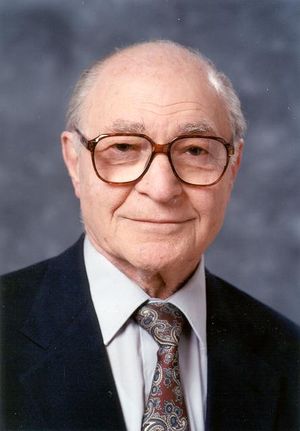Sol Triebwasser
- Associated organizations
- IBM
- Fields of study
- Microelectronics
- Awards
- IEEE Ernst Weber Managerial Leadership Award
Biography
Sol Triebwasser received the B.S. in Mathematics from Brooklyn College in 1941, and the M.S. and Ph.D. degrees in Physics from Columbia University in 1948 and 1952, respectively.
In 1952, Dr. Triebwasser joined IBM in Yorktown, NY and contributed in various areas of solid state physics including ferroelectricity, photoconductivity, injection lasers and MOS device physics. From 1957 to 1989 he was responsible for various applied research projects in the Research Division of IBM, including Large Scale Integration and Semiconductor Device Research, and was MOS Program Manager in the Advanced Silicon Technology Laboratory before assuming his position of Director of Technical Journals and Professional Relations in July of 1989.
During the latter half of the 1960s, Dr. Triebwasser was in charge of a major IBM program in Large Scale Integration (LSI) involving four of IBM's laboratories worldwide. During the course of this project, contributions to many of the foundations of today's microelectronics industry were laid, including: the development of NMOS technology; comprehensive theoretical and practical technology device and circuit publications; logic and memory circuit designs; placement and wiring and other design automation programs; optical and electron beam art work generators; and high current capacity thin films. One of Dr. Triebwasser's group, Robert Dennard, invented the one device memory cell, the basis of all DRAM chips today, during the course of the project. Many of the contributions and the participants in the project have been recognized by the IEEE and by IBM awards.
Dr. Triebwasser is a Fellow of the IEEE, the American Physical Society, and the American Association for Advancement of Science, and a member of Sigma Xi. He has served as chairman of the IEEE Awards Board and of the IEEE International Solid State Circuits Conference. He has also served on the Advisory Board of the IEEE Circuits and Devices Magazine, the IEEE Publications Board, the IEEE Solid State Circuits Council, and the IEEE Technical Activities Board Awards and Recognition Committee. He served on the Committee on the Applications of Physics of the American Physical Society as well.
Before joining IBM, Dr. Triebwasser served as an Army Signal Corps Officer during World War II and taught Physics at the Brooklyn College campus of the City University of New York. His Ph.D thesis on the Lamb Shift in Hydrogen was part of the body of work for which Willis Lamb received the Nobel Prize in Physics in 1955.
Sol Triebwasser resides with his wife, Mildred, in Cortlandt Manor, New York. They have two children and three grandchildren.
